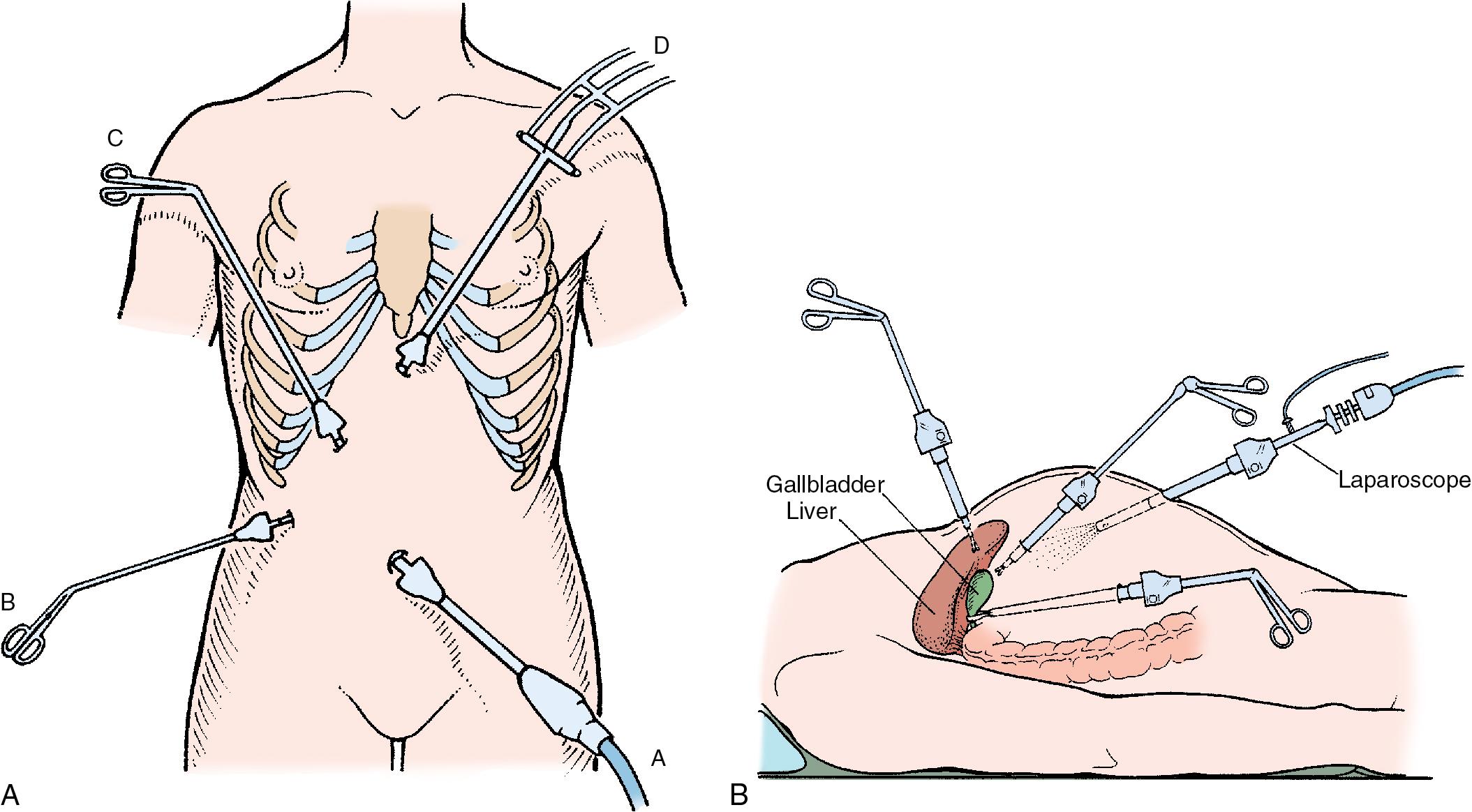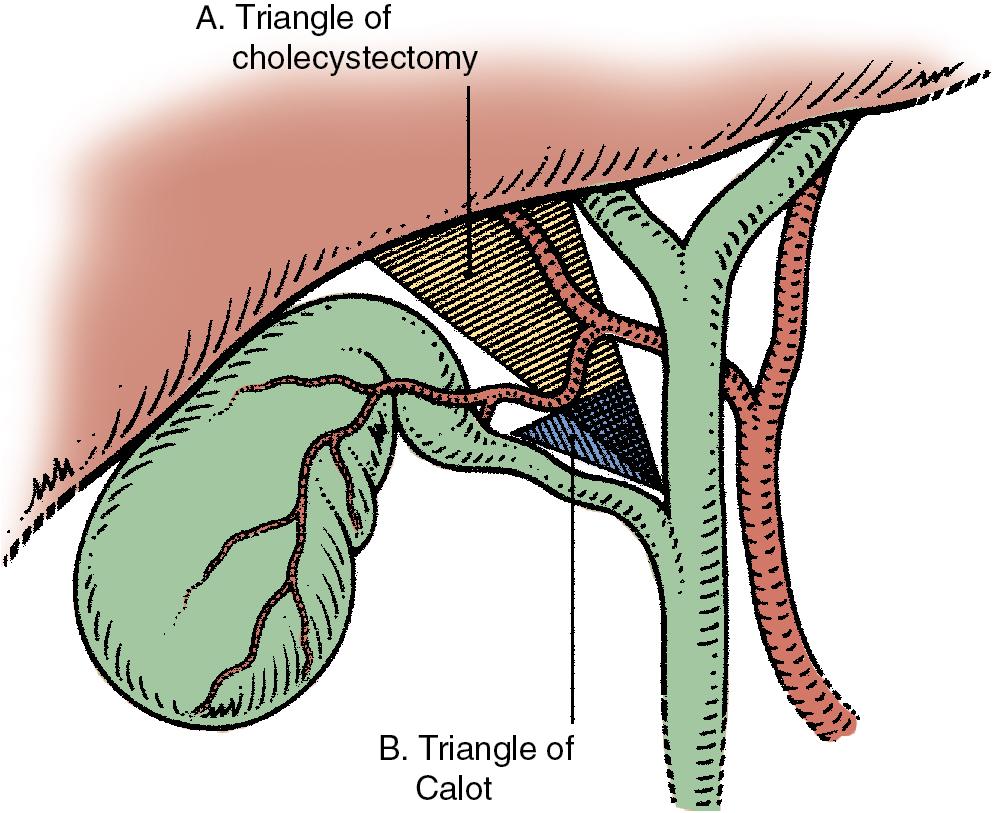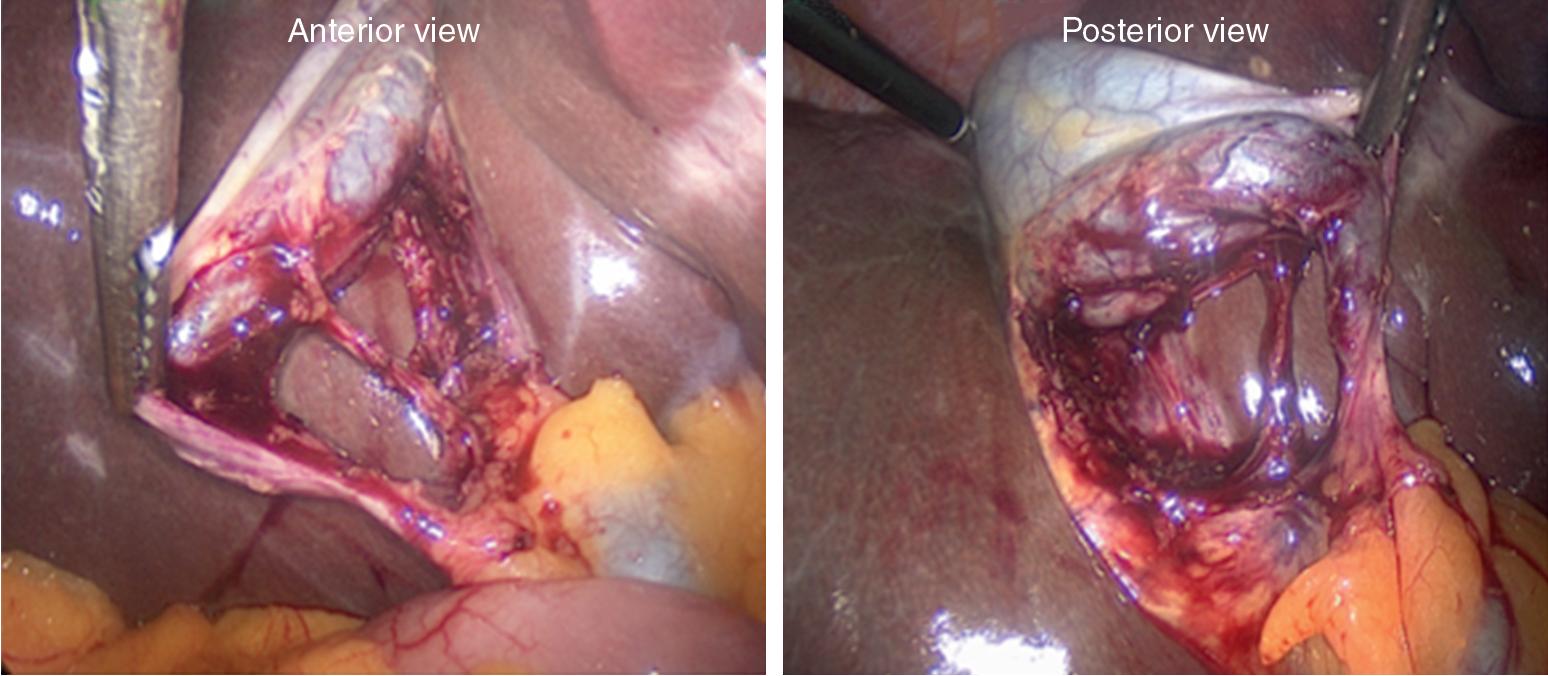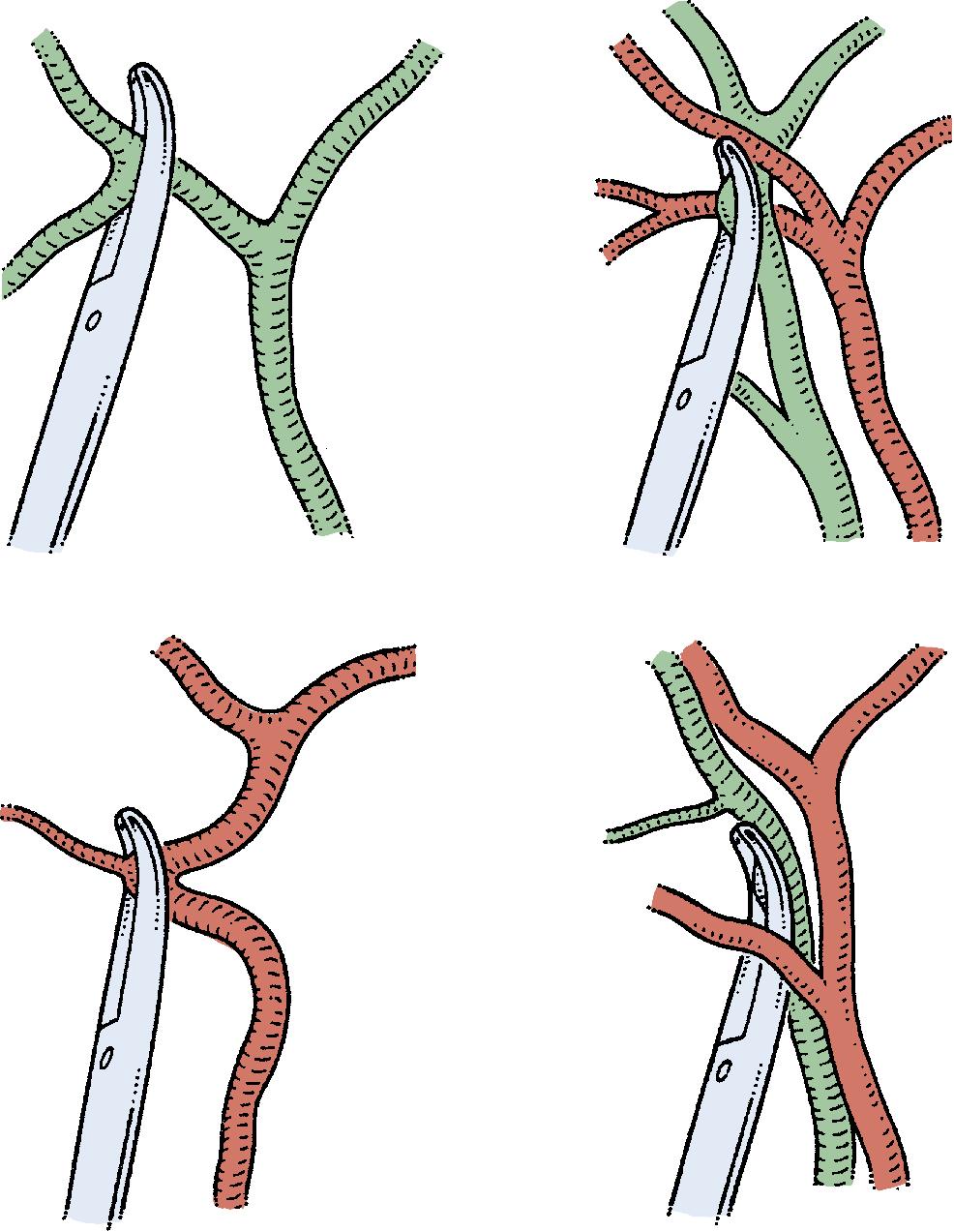Physical Address
304 North Cardinal St.
Dorchester Center, MA 02124
Cholecystectomy is one of the most frequently performed general surgery procedures in the United States (US) with over 500,000 being performed annually. There are many reasons for this, including the frequency of gallbladder disease and indications for intervention in the US population. The advent of laparoscopic cholecystectomy in the 1980s also resulted in a rapid rise in the number of cholecystectomies because of the reduced postoperative recovery, reduced pain, and ability to complete the procedure in the outpatient setting. , As familiarity with laparoscopy has increased, the incidence of open cholecystectomy has steadily decreased. This chapter will address techniques of open cholecystectomy because this approach is still used when laparoscopy is contraindicated or technically impossible. Appropriate laparoscopic cholecystectomy techniques will also be discussed, including strategies to prevent common bile duct injuries (CBDI), which are an avoidable source of severe morbidity with this procedure. Alternative minimally invasive approaches and common complications will also be addressed.
Symptomatic gallstones are the primary reason a patient requires cholecystectomy (see Chapters 33 and 34 ). In the US, approximately 5% to 22% of the population has cholelithiasis. Cholelithiasis can lead to several pathologic conditions including biliary colic, acute cholecystitis, gallstone pancreatitis, or choledocholithiasis, but the majority of patients with cholelithiasis will remain asymptomatic (see Chapter 33 ). As such, prophylactic cholecystectomy in asymptomatic patients is typically not warranted. Nevertheless, cholecystectomy may be indicated for certain populations with asymptomatic cholelithiasis. An example is sickle cell anemia where hepatic and vaso-occlusive disease can be indistinguishable from acute cholecystitis.
Gallbladder polyps without cholelithiasis can be an indication for cholecystectomy (see Chapter 49 ). Resection is recommended for gallbladder polyps greater than or equal to 10 mm and in patients with biliary symptoms in the setting of gallbladder polyps of any size. Cholecystectomy is also often performed concomitantly with other procedures. Examples include pancreaticoduodenectomy and major anatomic liver resections. Cholecystectomy at the time of bariatric surgery is controversial. It is thought that biliary symptoms increase after extreme weight loss. Nevertheless, a systematic review and meta-analysis reported that concomitant cholecystectomy increases postoperative morbidity and operative time (see Chapter 34 ).
Timing of cholecystectomy can vary by indication. Acute cholecystitis cases should proceed to the operating room as early as possible. A recent study using a Swedish registry found that adverse events, mortality, and CBDIs were higher in patients who underwent cholecystectomy more than 4 days after admission. These data suggest the optimal timing for cholecystectomy is within 48 hours of admission for acute cholecystitis.
Laparoscopy has become the standard access for removing the gallbladder. Multiple studies have shown a decrease in postoperative pain, an earlier return to normal activity, a decrease in hospital length of stay (LOS), and a reduction in incisional hernia development for laparoscopic cholecystectomy when compared with open cholecystectomy. Familiarity with the anatomy of the porta hepatis, including common biliary and vascular variations, can reduce complication rates for both laparoscopic and open cholecystectomy, particularly for challenging cases presenting with significant inflammation.
Before beginning any procedure, the surgeon must ensure that all equipment is present and functional, which includes equipment for potentially necessary procedures such as cholangiography or need for conversion to laparotomy ( Box 36.1 ).
Camera light source
Laparoscope (5-mm and 10 mm, 30 degree)
Monitors (one over each shoulder)
Insufflator and tubing
Trocars (multiple 5-mm trocars and at least one 10-mm)
Clips (5-mm and 10-mm variety)
Electrocautery
Suction
Irrigation
Atraumatic graspers
Maryland grasper (or laparoscopic right angle grasper)
Endoscopic retrieval bag
Endoloop
Laparoscopic needle driver
Absorbable hemostatic agent
Staplers
Argon laser
Cholangiography equipment (catheter, injectable contrast, c-arm for fluoroscopy)
Open cholecystectomy tray and instruments
Once pneumoperitoneum is obtained, a 5- or 10-mm port is placed in the periumbilical region. A 30-degree laparoscope is inserted, and the abdominal cavity is inspected. One 5-mm trocar is placed along the right anterior axillary line 2 centimeters below the costal margin. The other 5-mm port is placed at the midclavicular line on the right at the edge of the liver. A fourth port (5- or 10-mm) is placed in the subxiphoid region and should be placed 2 to 4 centimeters below the xiphoid depending on the location of the gallbladder and falciform ligament ( Fig. 36.1 ). A fifth port can be placed in the location deemed most appropriate for additional retraction, if necessary.

An atraumatic grasper is placed through the most lateral port and grasps the fundus of the gallbladder to retract it cephalad and laterally. This raises the liver edge and exposes the neck of the gallbladder and the porta. With the gallbladder retracted cephalad, a second atraumatic grasper is placed through the midclavicular port to manipulate the infundibulum of the gallbladder. Adhesions should be taken down until the gallbladder infundibulum can be seen. Retraction of the infundibulum caudally and to the right exposes the triangle of Calot. A cautery instrument placed through the xiphoid port opens the peritoneum in the triangle of Calot ( Fig. 36.2 ). This should be started at the edge of the gallbladder neck to avoid iatrogenic injury to aberrant hepatic vasculature or bile ducts. Dissection of the peritoneum is continued on both sides of the gallbladder 1 to 2 mm from the liver edge.

Attention is next turned to obtaining the critical view of safety (CVS). This technique has been shown to reduce the rates of iatrogenic bile duct injuries (see Chapters 32 and 42 ). In fact, a recent multisociety consensus statement recommended CVS for identification of the cystic duct and cystic artery during laparoscopic cholecystectomy, and when CVS was not attainable, a subtotal cholecystectomy should be performed rather than attempting a fundus-first approach (see Chapter 34 ).
Attachments at the neck of the gallbladder are dissected using a combination of blunt and cautery assisted dissection. It is useful to serially retract the infundibulum medially and laterally to fully dissect the triangle of Calot. Carrying dissection to the level of the common bile duct (CBD) is not indicated because this only increases the risk for iatrogenic injury. Blunt dissection with a Maryland grasper or right-angle grasper can help create a window behind the cystic duct by spreading in the avascular tissue. The gallbladder is dissected off the liver edge, exposing the cystic plate. The criteria for CVS have been met when (1) there are only two structures seen entering the gallbladder, the cystic duct and cystic artery; (2) the lower third of the cystic plate is exposed; and (3) tissue has been cleared from the hepatocystic triangle so that all structures can be clearly identified anteriorly and posteriorly ( Box 36.2 ). These views are demonstrated in Fig. 36.3 . If any question or doubt about the anatomy is encountered, a cholangiogram should be performed to reorient the surgeon (see Chapter 24 ).
Two structures connected to gallbladder:
Only two structures clearly seen entering the gallbladder.
Cystic plate:
Approximately 1/3 of cystic plate is clearly visible.
Clearance of hepatocystic triangle:
Hepatocystic triangle is cleared of tissue so visibility of cystic structures and plate is unimpeded and the surgeon is certain no other structures are in the hepatocystic triangle.

Most surgeons attempt the CVS during laparoscopic cholecystectomy, but in practice it is rarely achieved. An evaluation of 160 online videos of laparoscopic cholecystectomy found only one video accomplished a passing CVS score. The safe cholecystectomy curriculum can be found free of charge at the Society of American Gastrointestinal and Endoscopic Surgeons (SAGES) website.
Once all critical anatomy is confirmed, the cystic artery and duct are clipped and divided. Care should be taken to avoid tenting the CBD with clips placed too distally on the cystic duct. The tips of the clip should be directly visualized to be free before closing to avoid inadvertent injury to other structures and ensure the clip completely occludes the artery or duct. If it is not possible to secure a clip completely across a structure, an Endoloop device can be used to ligate it. Scissors are used to divide the cystic artery and duct. In rare cases with a large inflamed cystic duct that cannot accommodate clips, endovascular staplers can be used to divide and secure the duct. These situations, however, should raise the level of concern regarding possible injury to the CBD, and the surgeon should consider intraoperative cholangiography if there is any concern whatsoever regarding the anatomy. Cautery is avoided for division because of the increased risk for necrosis resulting in clip slippage. The gallbladder is dissected off the cystic plate from the infundibulum to the fundus with electrocautery. Blindly placing clips, clamps, or cauterizing at this time risks causing hemorrhage or inadvertent injury to the hepatic blood supply, superficial biliary pedicles, or middle hepatic vein branches and should be avoided ( Fig. 36.4 ). Before completely freeing the gallbladder from the liver, the gallbladder is used for retraction to inspect the cystic plate for hemostasis and inspect that clips are still securely placed on the cystic duct and artery.

Specimen removal is performed through the periumbilical incision because it is easy to enlarge this incision to extract large gallstones. Bag extraction is performed with videoscopic visualization to ensure the bag does not rip and specimen contents are not lost. Spilled bile or debris should be completely irrigated and cleared with suction to prevent subsequent migration or abscess formation. The fascia of port sites greater than 10 mm are closed to prevent development of incisional hernias although some surgeons elect not to close the epigastric site because herniation is unlikely in that location.
Become a Clinical Tree membership for Full access and enjoy Unlimited articles
If you are a member. Log in here